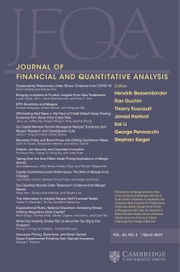Article contents
Competition and the Reputational Costs of Litigation
Published online by Cambridge University Press: 14 March 2025
Abstract
We study the role of competition in customers’ reactions to litigation against firms, using anonymized mobile phone location data. A class action lawsuit filing is followed by a 4% average reduction in customer visits to target firms’ outlets in the following months. The effect strongly depends on competition. Outlets facing more competition experience significantly larger negative effects. Closer competition matters more, both in terms of geographic and industry proximity. Announcement returns and quarterly accounting revenues around lawsuit filings also strongly depend on competition. Our results suggest that competition is an important component in customers’ ability to discipline firms for misbehavior.
Information
- Type
- Research Article
- Information
- Journal of Financial and Quantitative Analysis , Volume 60 , Issue 7 , November 2025 , pp. 3412 - 3442
- Creative Commons
- This is an Open Access article, distributed under the terms of the Creative Commons Attribution licence (http://creativecommons.org/licenses/by/4.0), which permits unrestricted re-use, distribution and reproduction, provided the original article is properly cited.
- Copyright
- © The Author(s), 2025. Published by Cambridge University Press on behalf of the Michael G. Foster School of Business, University of Washington
Footnotes
We appreciate the helpful comments from Ran Duchin (the editor) and an anonymous referee as well as Yakov Amihud, Efraim Benmelech, Jasmin Gider, Gerard Hoberg, Mikael Homanen, William Johnson, Jonathan Karpoff, Peter Limbach, Guy Liu, Sibo Liu, Fangyuan Ma, Alberto Manconi, Jean-Marie Meier, Kasper Meisner Nielsen, Adair Morse, Holger Mueller, Mikael Paaso, Bruno Pellegrino, Marc Steffen Rapp, Martin Schmalz, Thomas Schmid, Steven Davidoff Solomon, Rok Spruk, Laura Starks, Philip Valta, Petra Vokata, Leyuan You, and Alminas Žaldokas as well as seminar and conference participants at WHU – Otto Beisheim School of Management, University of St. Gallen, 2021 China International Conference in Finance (CICF), 2021 CEPR Endless Summer Conference, 2021 Paris December Finance Meeting, 2021 Swiss Finance Institute (SFI) Research Days, 2021 Workshop on Corporate Governance and Investment (WCGI), 2021 International Young Finance Scholars’ Conference, 2021 Corporate Finance Day, 2021 European Association for Research in Industrial Economics (EARIE) Conference, 2021 Financial Management Association (FMA) Conference, 2021 Swiss Society for Financial Market Resarch (SGF) Conference, 2022 Western Finance Association (WFA) Conference, 2022 and German Finance Association (DGF) Conference. The authors have no conflicts of interest to disclose. All errors are ours.
References
- 1
- Cited by

